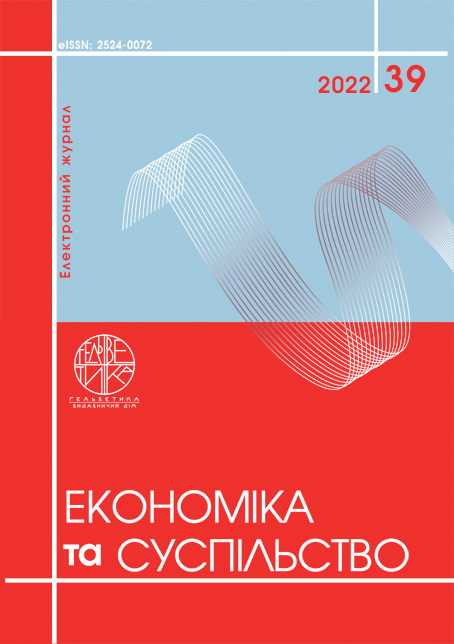THE ROLE OF MARKETING INNOVATIONS IN THE GASTRONOMIC TOURISM DEVELOPMENT IN THE REGION
Abstract
The article deals with the substantiation of the role of marketing innovations in the gastronomic tourism regional development, in particular on the example of Lviv region. Methods of analysis of literary sources, scientific synthesis and generalization, project, comparative and system-structural methods are used. Gastronomic tourism is a promising type of tourism activity, which uses the peculiarities of tourist nutrition not only as a basic element of providing services in the place of temporary stay, but also as a separate attractive component of destinations. Gastronomic tourism itself is an innovation for many countries and regions, but even in those territories where this branch of activity is not new, the problem of determining the directions of its innovative development is relevant. Innovative factors influencing the development of gastronomic tourism in the region include clusters, new projects, new technologies, environmentally friendly activities, conceptual institutions, social media marketing. Such marketing innovations in the regional development of gastronomic tourism as new projects, new technologies and marketing in social networks are described in detail. Examples of their successful implementation are given, in particular in Lviv region. Territorial branding is an important process involving various marketing innovations in the gastronomic tourism regional development. The gastronomic culture of the territories is naturally one of the most expressive aspects of destination branding, and has examples of successful use, particularly in Lviv. Marketing innovations in gastronomic tourism involve the creation of a new or update an existing gastronomic product and its promotion in the tourism market. The application of marketing innovations allows for the rapid development of gastronomic tourism, increasing the competitiveness of tourist regions, increasing demand, increasing sales of gastronomic products, meeting the diverse needs of consumers. Marketing innovations in the development of gastronomic tourism are especially relevant in the period of the tourism industry out of the crisis.
References
Басова В., Голод А. Проблеми та перспективи розвитку гастрономічного туризму у Західному регіоні України. Сучасний стан, проблеми та перспективи розвитку туризму в регіонах України : матеріали ІІІ Всеукр. наук.-практ. конф. (м. Львів, 19-20 жовтня 2018 р.). Львів, 2018. С. 62–64.
Басюк Д.І. Інноваційний розвиток гастрономічного туризму в Україні. Наукові праці Національного університету харчових технологій. 2012. № 45. С. 128–132.
Голод А., Никига О. Інноваційні фактори розвитку гастрономічного туризму у Львівській області. Проблеми активізації рекреаційно-оздоровчої діяльності населення : матеріали ХІІ Міжнар. наук.-практ. конф. (23–24 квітня 2020 р., м. Львів). Львів, 2020. С. 279–282.
Голод А.П., Гончаренко М.Ф., Никига О.В., Євдощенко О.В. Інноваційні засади сталого розвитку етногастрономічного туризму в регіоні. Менеджер. Вісник Донецького державного університету управління. Серія Економіка. 2020. № 4 (89). C. 40–47.
Ілляшенко С.М. Інноваційний менеджмент. Суми : ВТД Університетська книга, 2010. 334 с.
Курбацька Л.М., Кадирус І.Г. Впровадження маркетингових інновацій в діяльність промислових підприємств. Економіка та держава. 2020. № 4. С. 187–190.
Paska M., Korkuna O., Kulyk O. Current development trends of raw-smoked sausages in the context of gastronomic tourism. Trends in the development of international tourism in the current context of globalization : Collective scientific monograph. Opole, 2020. P. 152–158.
Ukraine Travel Lab. URL: https://ukrtravellab.com.ua/
Basova V., Holod A. (2018) Problemy ta perspektyvy rozvytku hastronomichnoho turyzmu u Zakhidnomu rehioni Ukrainy [Problems and prospects of gastronomic tourism in the Western region of Ukraine]. Suchasnyi stan, problemy ta perspektyvy rozvytku turyzmu v rehionakh Ukrainy : materialy III Vseukr. nauk.-prakt. konf. (m. Lviv, 19-20 zhovtnia 2018 r.). Lviv. S. 62–64. (in Ukrainian)
Basiuk D.I. (2012) Innovatsiinyi rozvytok hastronomichnoho turyzmu v Ukraini [Innovative development of gastronomic tourism in Ukraine]. Naukovi pratsi Natsionalnoho universytetu kharchovykh tekhnolohii. № 45. S. 128–132. (in Ukrainian)
Holod A., Nykyha O. (2020) Innovatsiini faktory rozvytku hastronomichnoho turyzmu u Lvivskii oblasti [Innovative factors of gastronomic tourism development in Lviv region]. Problemy aktyvizatsii rekreatsiino-ozdorovchoi diialnosti naselennia : materialy KhII Mizhnar. nauk.-prakt. konf. (23–24 kvitnia 2020 r., m. Lviv). Lviv. S. 279–282. (in Ukrainian)
Holod A.P., Honcharenko M.F., Nykyha O.V., Yevdoshchenko O.V. (2020) Innovatsiini zasady staloho rozvytku etnohastronomichnoho turyzmu v rehioni [Innovative principles of sustainable development of ethno-gastronomic tourism in the region]. Menedzher. Visnyk Donetskoho derzhavnoho universytetu upravlinnia. Seriia Ekonomika. № 4 (89). S. 40–47. (in Ukrainian)
Illiashenko S.M. (2010) Innovatsiinyi menedzhment [Innovation management]. Sumy : VTD Universytetska knyha. 334 s. (in Ukrainian)
Kurbatska L.M., Kadyrus I.H. (2020) Vprovadzhennia marketynhovykh innovatsii v diialnist promyslovykh pidpryiemstv [Introduction of marketing innovations in the activities of industrial enterprises]. Ekonomika ta derzhava. № 4. S. 187–190. (in Ukrainian)
Paska M., Korkuna O., Kulyk O. (2020) Current development trends of raw-smoked sausages in the context of gastronomic tourism. Trends in the development of international tourism in the current context of globalization : Collective scientific monograph. Opole. P. 152–158.
Ukraine Travel Lab. Available at: https://ukrtravellab.com.ua/


